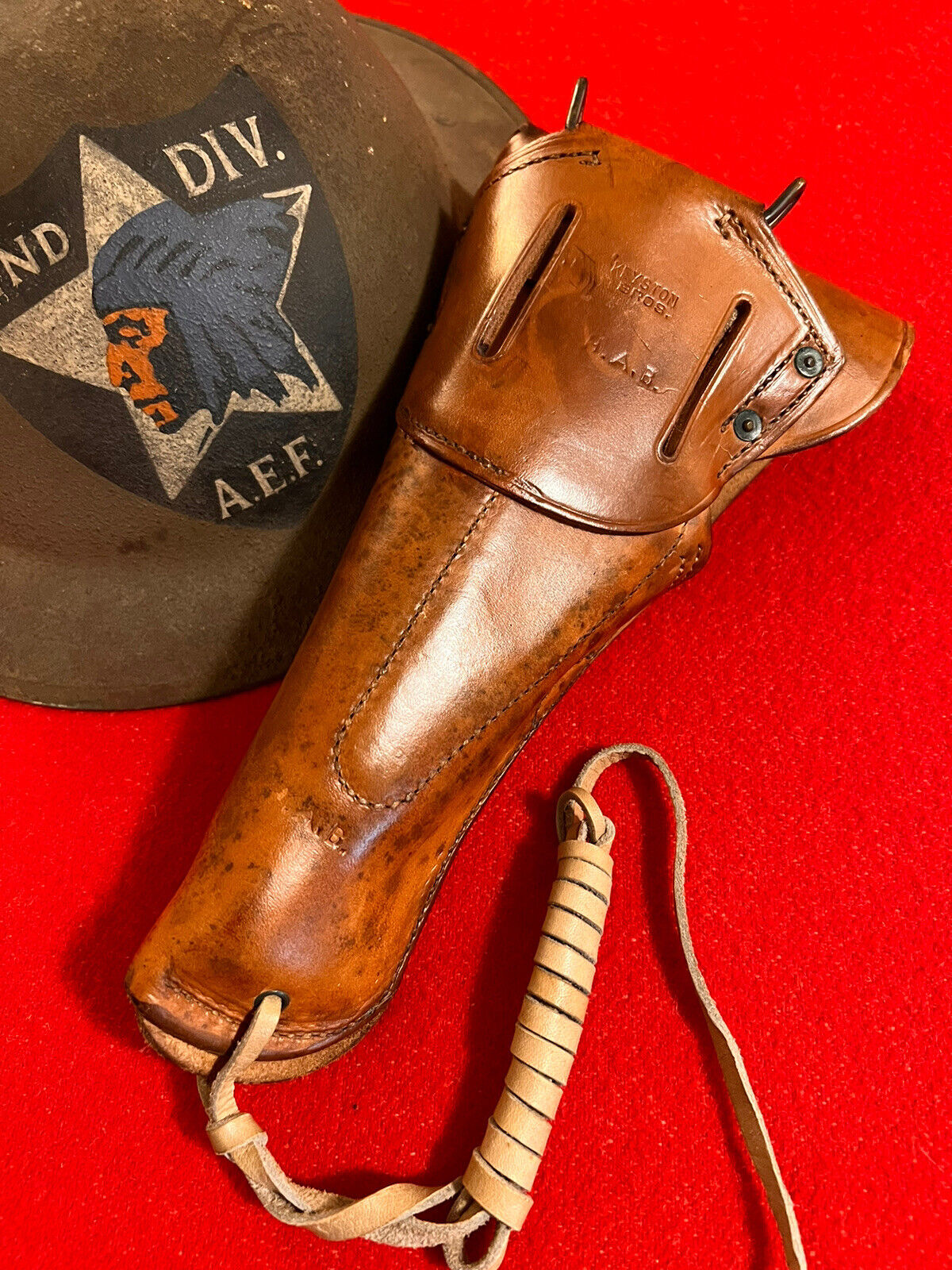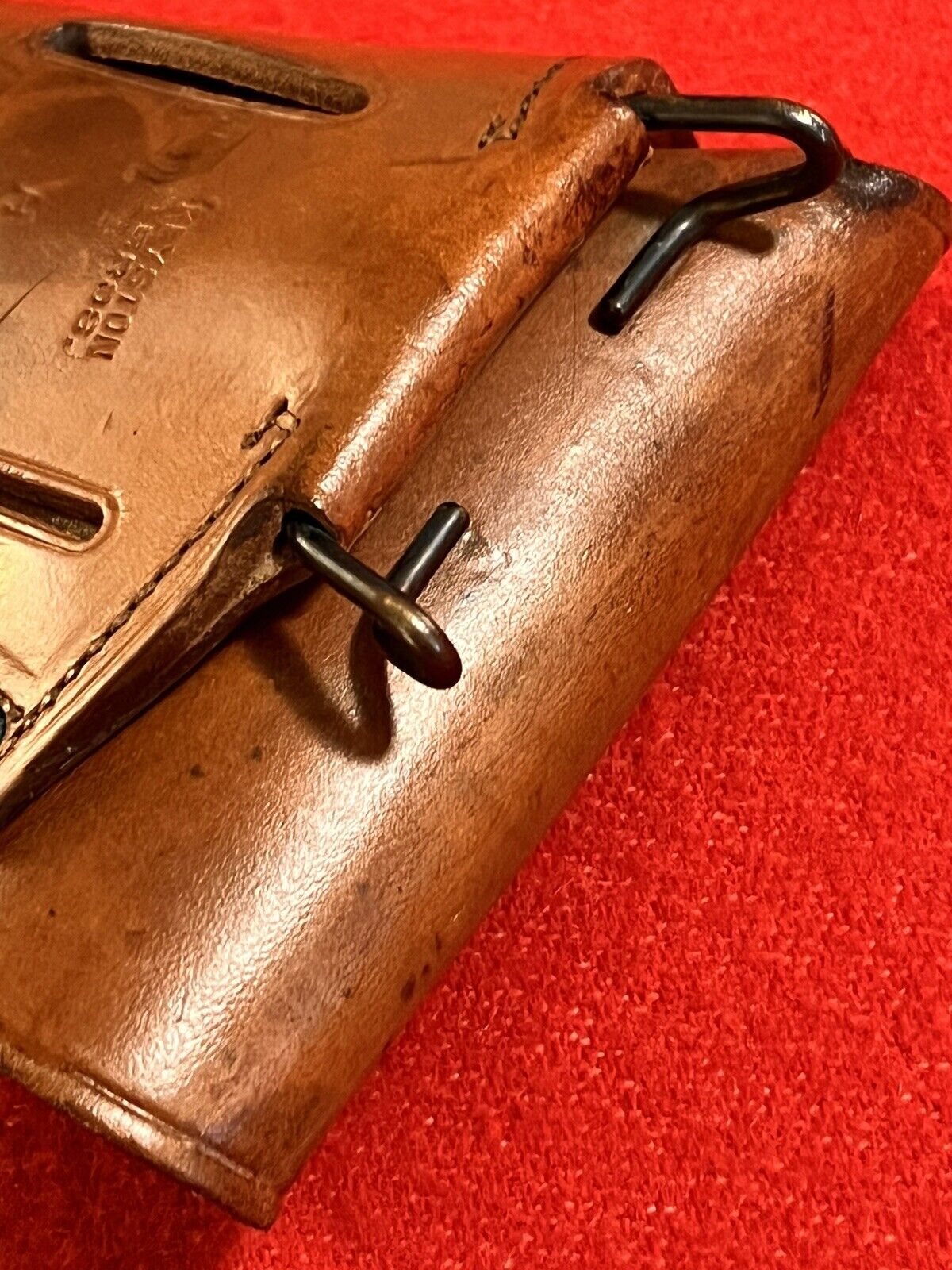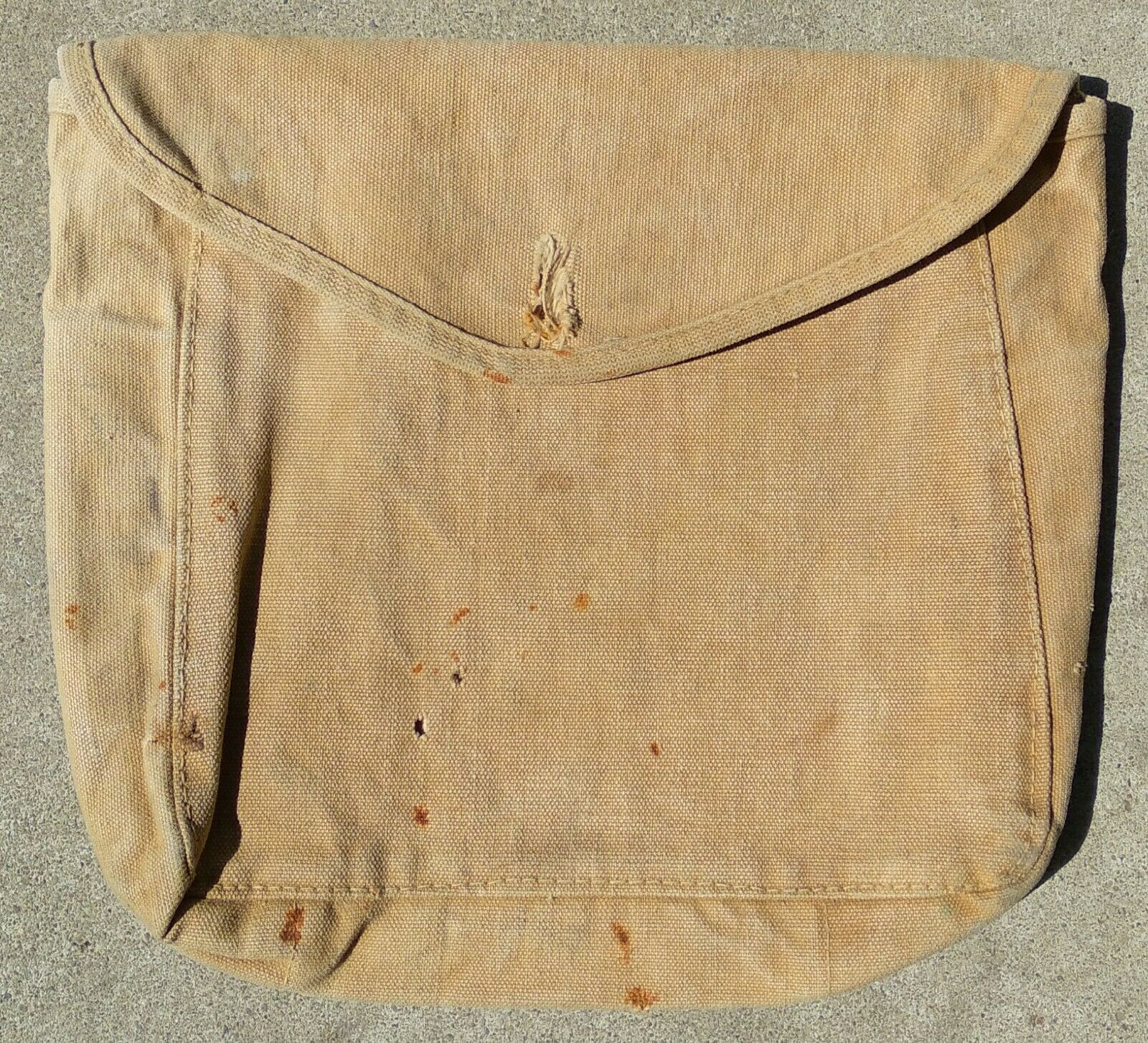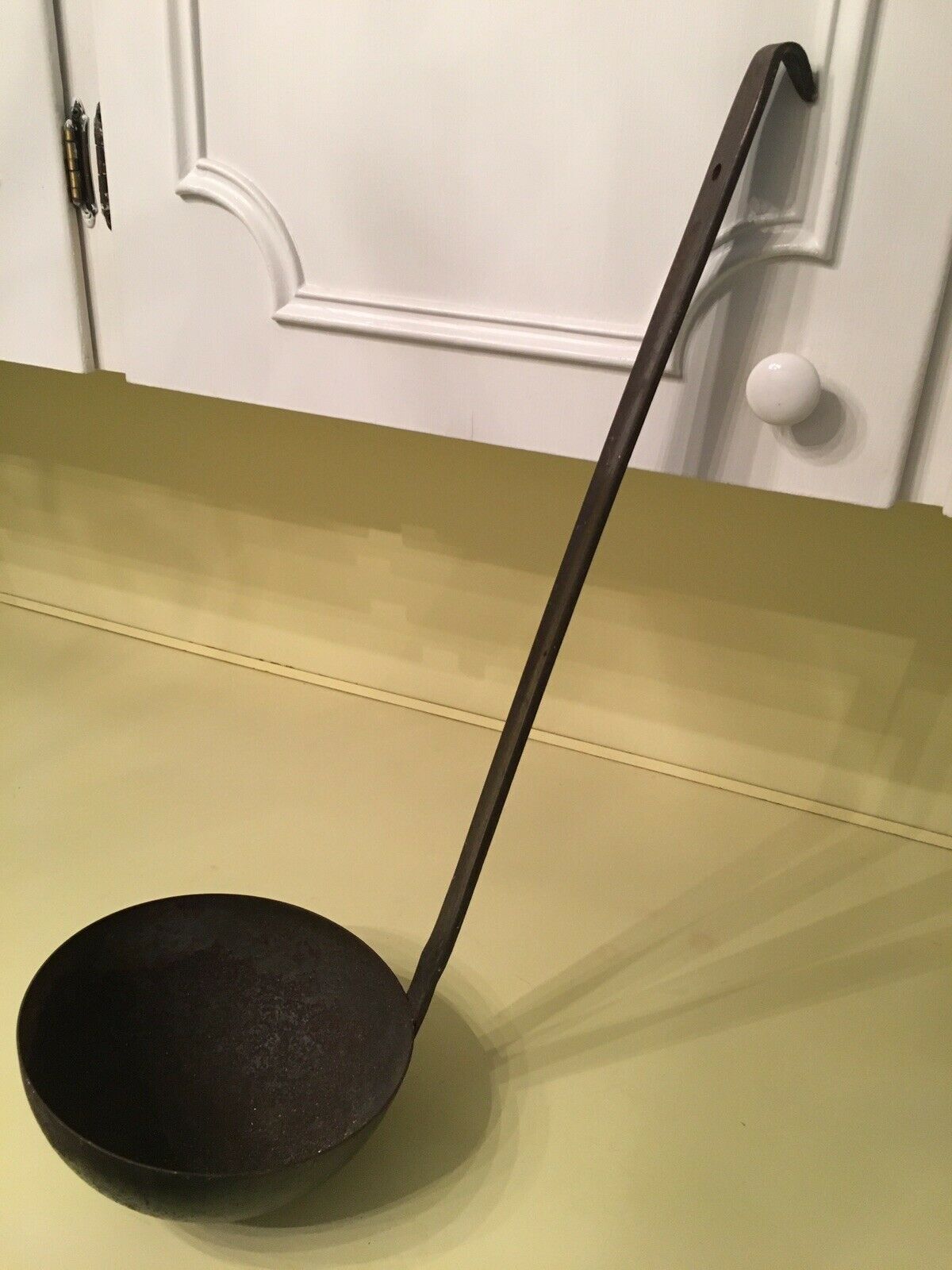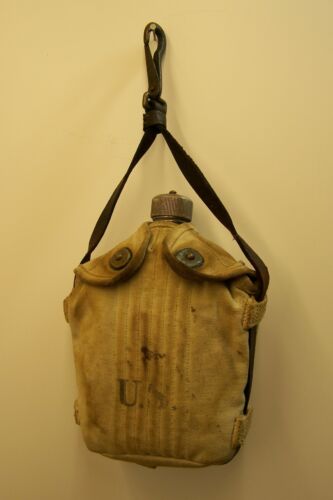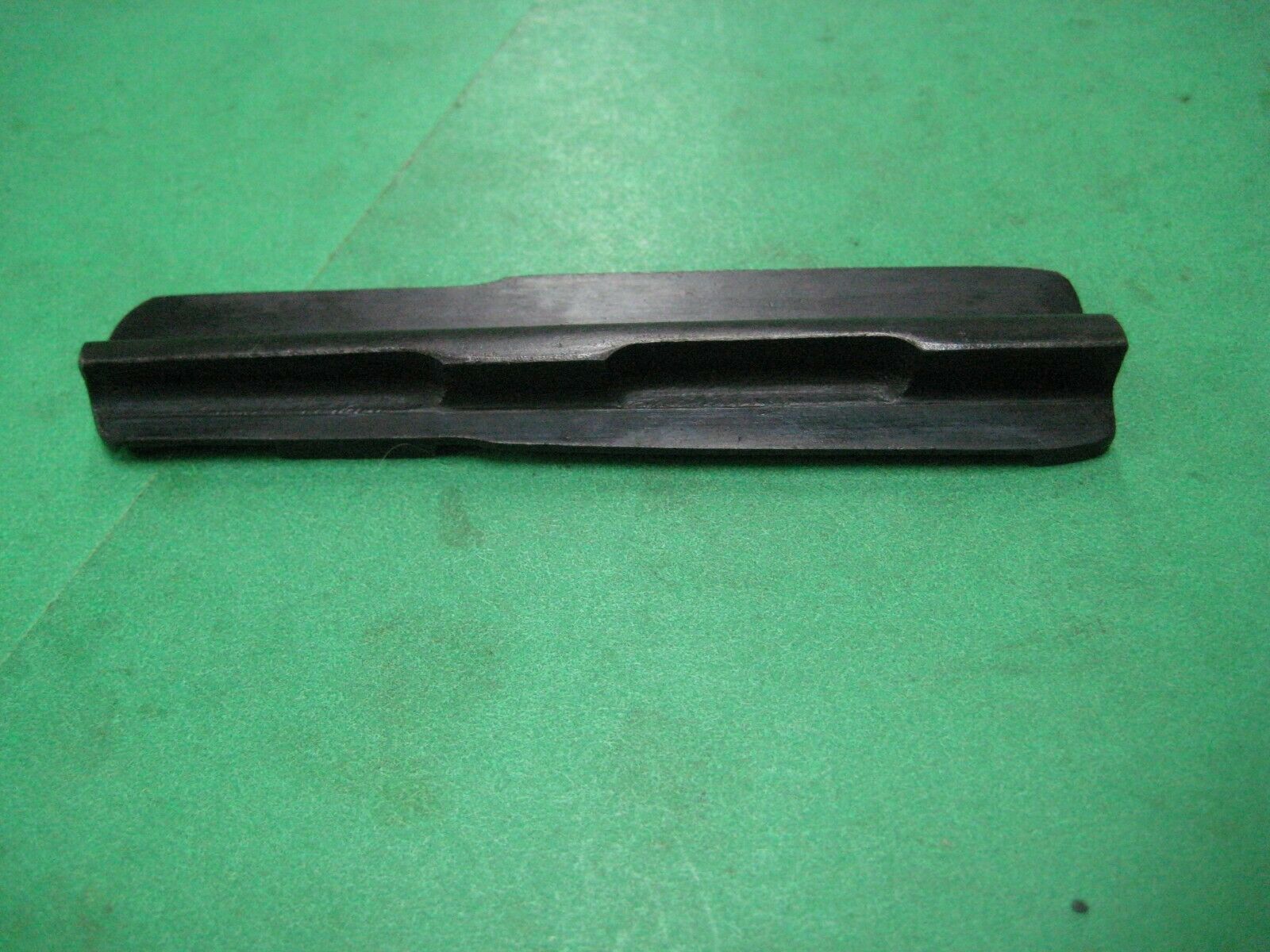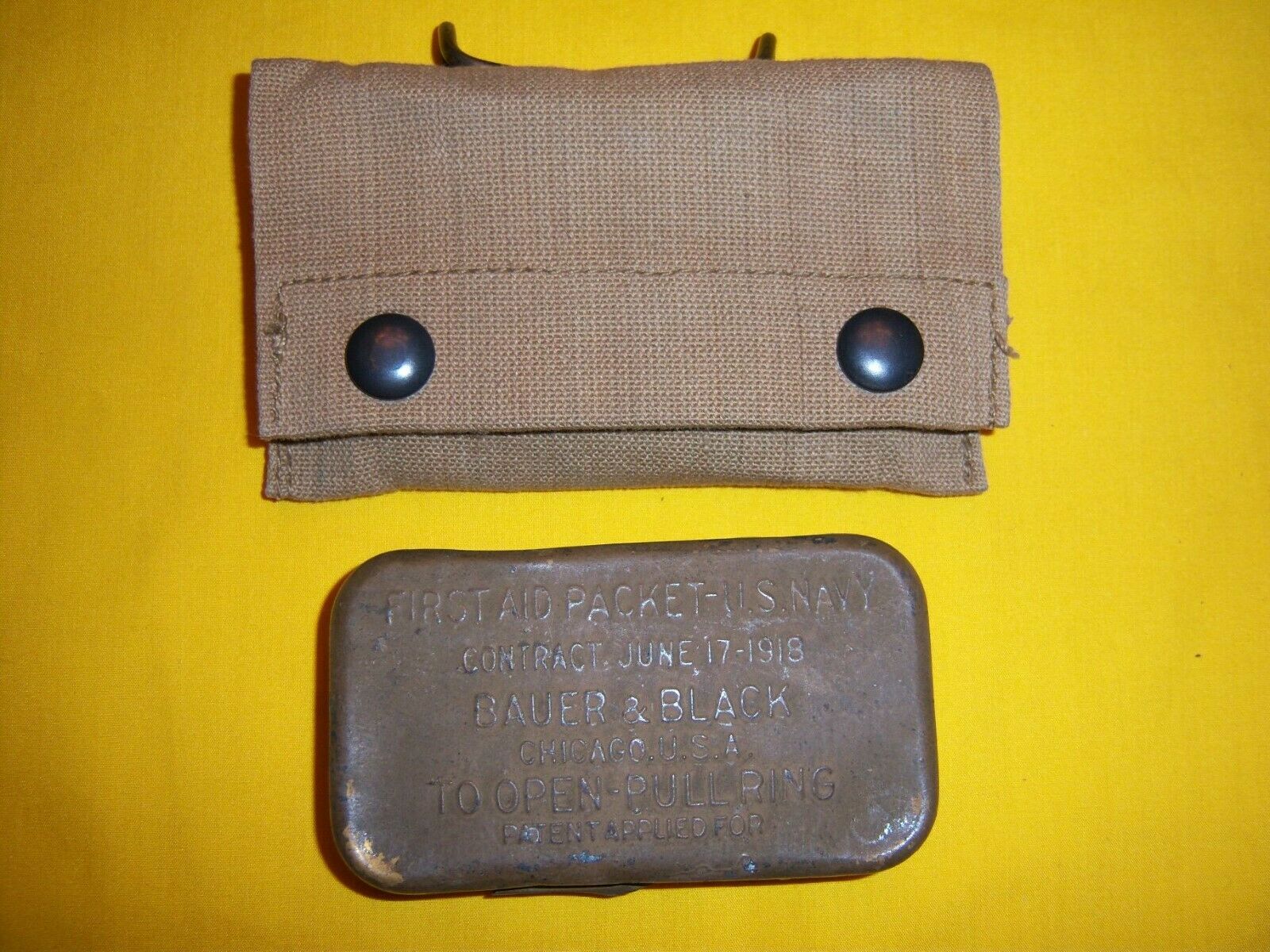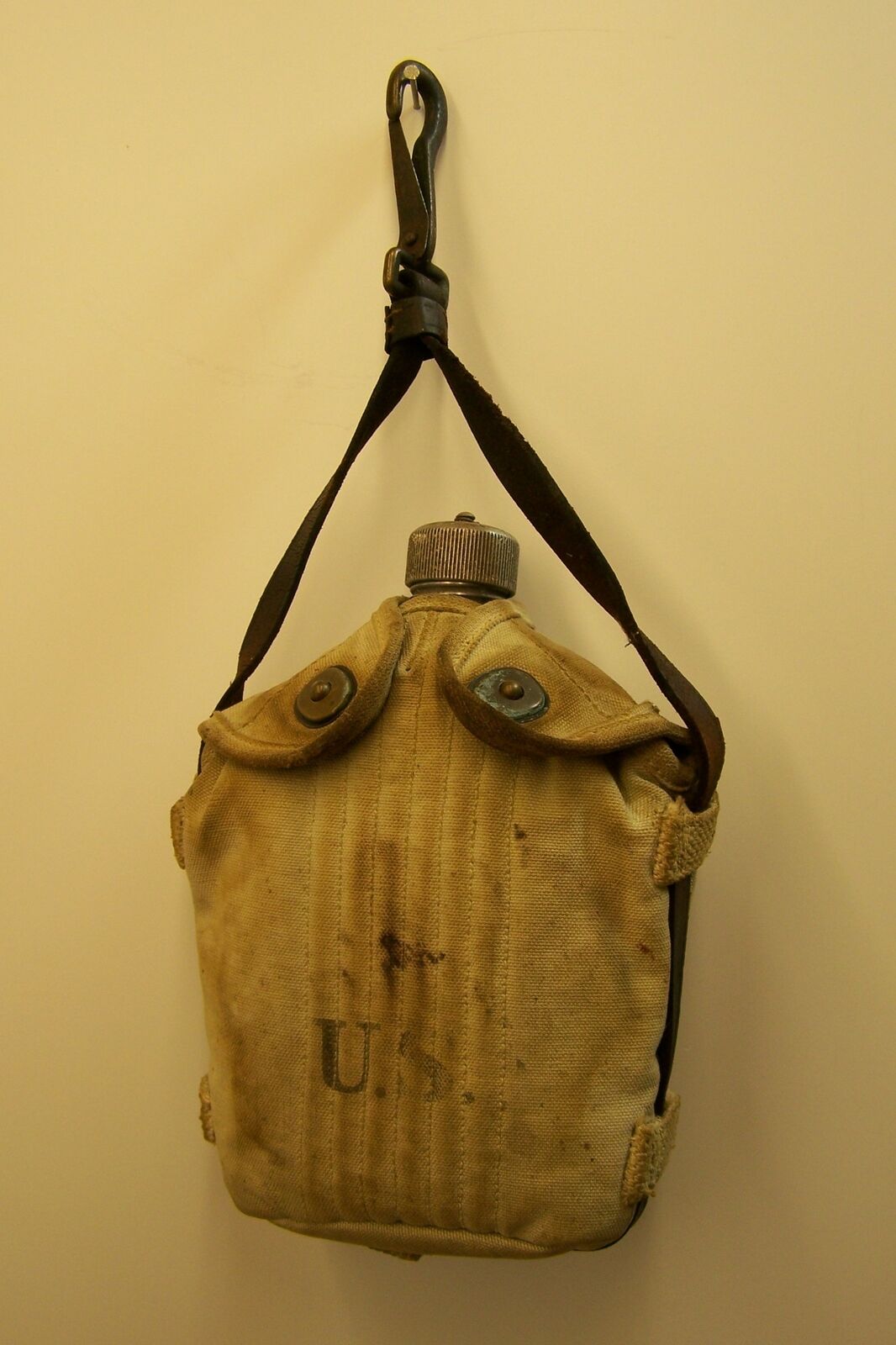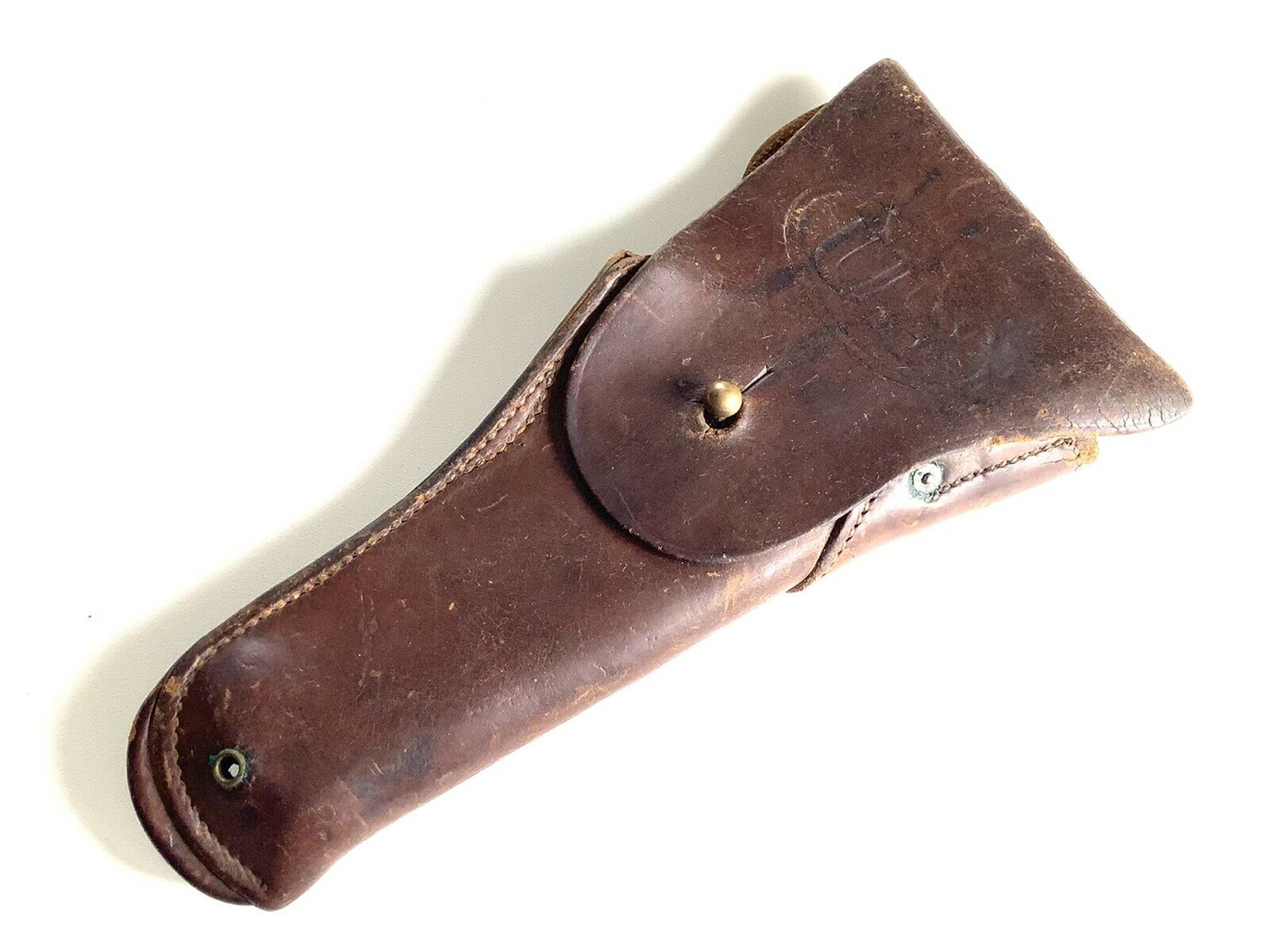-40%
WWI M1916 Holster ( KEYSTON BROS. ) & Lace (for M1911 .45 ACP) Near Mint!
$ 125.4
- Description
- Size Guide
Description
WWI M1916 Holster ( KEYSTON BROS. ) & Original Elkhide Lace (for M1911 .45 ACP)Near Mint!
These simply do not turn up often, let alone in
"superb"
condition like this one.
This First World War
“U.S.”
deeply embossed
"KEYSTON BROS."
M1916
Holster from the FAMOUS San Francisco saddlery in made in 1917, was what was issued to the
ARMY, U.S. MARINE CORPS
and the
NAVY
during WWI and, as were all of the WWI-era Holsters reissued to personnel during the Second World, especially the first several years.
There were no
M1916
Holsters
specifically stamped on the Flap with
“USMC”
or
“USN”
during WW2 and Marines in the Pacific may just as likely have worn a WWI M1916 model.
This
M1916 Holster
was worn by
Marine
and
Army Officers, NCOs,
personnel with
crew-served weapons, Aviators
and
Pilots --
many of whom chose to carry
the
large frame
M1911 .45 ACP
in a belt holster such as this one -- and any other Marine or Soldier who could lay his hands on a side arm!
*****
PARTICULARS of CONDITION:
-
Unbelievable
STRONG,
flexible
LEATHER
!! Absolutely perfect shape -- never crushed, or deformed! This example has never been subjected to neatsfoot oil, saddle soap (both of which break down the fibers of the leather), or dyes over the past 105 years!
-
ZERO
dry rot, deterioration of any sort, "crazing," splits, graffiti, verdigris, pulled rivets, loose linen stitching!!
- The
RARELY SEEN
name of
KEYSTON BROS."
of San Francisco
is crisply stamped in
serif
font capital letter on the rear. No year of manufacture was ever stamped by this saddlery, although it is suspected that this was a 19167 contract.
- Additionally, the Inspector's initials of
"H.A.B."
are deeply stamped on the reverse in two places: (1) the toe of the Holster above the brass eyelet, and (2) on the M1910 Belt Hook Belt Slide Attachment piece.
-
FANTASTIC
color of
Light NATURAL
flesh-colored
Cowhide with mottled age spotting.
- The Leather at the point of attachment of the
M1910 Belt Hook
is
STRONG
and
100% FREE
of cracks, wear or
'crazing.'
-
ZERO
breaks in the
'Hole'
on the Flap for the
Brass STUD
only the gentle,
authenticating 'patina' of 77 years of age!
-
ZERO
significant scuffs, scratches, cuts, or crazing to the Leather! This example has never been destroyed with Neatsfoot Oil of black dye!
-
PERFECT
high relief
of the embossed
“U.S.”
within the "oval."
- The bright Brass
FLAP STUD
, all four of the
RIVETS,
the
two
EYELETS
for
Leather Lace TIE-DOWN
are still
SECURELY SET!
-Virtually
NO
traces of
VERDIGRIS
on the Rivets.
- Absolutely
PERFECT
finish and shape on the period-correct Blackened
Brass M1910 BELT HOOK.
-
ZERO
breaks in the
CORRECT ORANGE LINEN THREAD
! (Current Holsters and reproductions are seen with
WHITE POLYESTER
thread.)
-
ZERO
scuffs to the Block at the mouth of the Holster!
- The
Wooden BLOCK
at the Toe of the Holster is present and the Holster retains it's perfect
FACTORY-FRESH
condition. The leather-covered
Wooden BLOCK
near the Trigger Guard
(to cant the pistol Grip away from the wearer's body)
is
ALSO
in
PERFECT
condition with
ZERO
scuffs!!
-
ZERO cracks, breaks, "crazing," of dry rot to the heavy 48" gray
ELKHIDE
LACE
(which is often missing from many Holsters). Still strong,
UNBLEMISHED,
and still coiled!
*****
"KEYSTONE BROS. SAN FRANCISCO"
The great
Keyston Bros. Saddlery
of San Francisco was founded by James Keyston who began by making buggy whips and eventually expanded the business to include a complete saddlery and harness supply. They were known for impressive, exquisite custom parade saddles, bridles, and tack, lavishly adorned with silver work. The
"Exhibition Saddle"
made for display in the Keyson Bros. booth at the
Golden Gate International Exposition of 1939
, a World's Fair held on San Francisco's Treasure Island to commemorate the city's two new bridges and its Western legacy sold at
Brian Lebel's Mesa
auction in 2017 for 5,000.
Keyston Bros.
never produced their own bits and spurs but contracted with many of the same local makers that supplied other saddleries such as
LD Stone
or
Main and Winchester.
In 1906 the
Keyston Bros.
business was destroyed by the San Francisco earthquake and fire, but the company kept on and bought out some other saddleries and continued by selling through expanded catalog sales.
During the Great War they were contracted to make
M1916 Holsters
such as this one as well as other leather goods for the
War Departmen
t.
Keyston Bros.
ONLY
made M1916 Holsters during WWI!
Over time the company began selling other items and is actually still in business as of the time of this writing. Bits and spurs are typically marked
“Keyston Bros. San Francisco”
and can also be marked by the maker.
*****
EXCEPTIONAL research by Scott Meadows,
“A Word on Holsters: Part 2”
at “pre-98”
HISTORICAL CONTEXT AND ACTUAL USE
"From the time that war broke out in late 1941 until sometime in late 1943 almost all the holsters used by the American Forces in the field were leftover from WW1 as were most of the pistols. It is very common to find a vet brought back WW2
Colt
in a WW1 era issued holster. From an historical context a holster was a holster, they used what was available in the supply chain. 70 years later we collectors like to tidy things up a bit and stick WW2 made pistols in WW2 made holsters.
*****
KEYSTON BROS.
of San Francisco, Califronia today:
"In business since 1868,
Keyston Bros.
has grown from a small, family-owned business manufacturing and selling whips and lashes on the streets of San Francisco, to becoming one of the largest and most well-respected national jobbers in the industry.
Keyston Bros.
is one of North America’s leading suppliers and innovators of fabrics, vinyls, leathers and textiles to multiple markets including automotive, marine, and furniture upholstery supplies, as well as to the hospitality/contract, healthcare and fitness industries under its dedicated
KB Contract
division.
With more than 250 employees and 20 warehouse and branch locations throughout the country,
Keyston
offers unprecedented customer service, backed by coast-to-coast coverage, an expansive product line featuring in-stock inventory with just-in-time delivery, plus a pleasing mix of both affordable branded value options and proprietary offerings customized exclusively for our clients.
Besides its quality North American products,
Keyston Bros
. also offers a spectacular mix of customized imports featuring global sourcing from Norway, Italy, Columbia, Mexico, Canada, Thailand, Korea, Taiwan and China. New products represent the lifeblood of any business, and
Keyston Bros.
remains on the cutting edge of innovation in the niches it serves."
*****
The G.I. .45 in World War II
by Bruce Canfield, appearing in
American Rifleman,
April 6, 2010
"...a handgun was essentially a supplemental sidearm and was generally employed in actual combat action only when the more effective rifles and automatic arms were unavailable, out of ammunition or damaged. An Oct. 23, 1943, Marine Corps document titled
“Report on Infantry Weapons in Combat”
gave a brief synopsis of the various arms used by a Marine Raider Battalion on New Georgia Island. The section pertaining to the .45 ACP simply stated: "Held up very well, but used very little.”
"Many
.45 pistols
were acquired by troops who were not officially authorized to be issued them as called for in their unit’s
TOE (Table of Organization and Equipment)
. However, such regulations were rarely enforced in combat zones, and many G.I.s and Marines who could acquire
a .45
did so, and considered themselves lucky.
"A leather hip holster, the
Model of 1912,
was standardized soon after the
M1911’s
adoption. This holster had a swivel attachment to make it better adapted to cavalry use. Just before America’s entry into World War I, the
Model of 1916
holster was adopted, which differed from the
M1912
primarily in the deletion of the swivel feature. Both were fitted with wire hooks that attached to the grommets on the bottom of the standard webbed pistol belt or cartridge belt. There were sufficient numbers of World War I-vintage
M1916 holsters
to meet the demand until the U.S. became actively involved in World War II. The
M1916 holster
was put back into production and almost 3 million were made by 16 different commercial firms between 1941 and 1945. These holsters were embossed with a large
“U.S.”
on the cover flap, with the name of the maker and year of production on back.
"A
leather shoulder holster for the .45 pistol
, designated as the
“M3,”
was adopted in 1942 for use by aviators, tankers and others who preferred carrying the pistol over the hip holster.
An improved shoulder holster design was standardized in 1944 as the "M7." The pistol was secured in the shoulder holster by means of leather strap with a snap fastener. The shoulder holsters were also embossed with a large “U.S” on the front, with the identity of the manufacturer and year of production on the back.
"...It was not uncommon for soldiers and Marines to be armed with both carbines and .45 pistols. Nevertheless, the desire to replace the pistol with the carbine continued throughout the war. This was evidenced in a Jan. 26, 1943, Marine Corps document...
"Despite this official stance, pistols were issued in ever-increasing numbers during the war. As an example, the U.S. Marine Corps’ TOE
(Table of Organization and Equipment)
in 1942 authorized 798 .45 pistols for a Division but, by 1945, the authorized figure had been increased to 1,707. So much for efforts to get rid of the pistol. The situation was much the same in the U.S. Army where the carbines and .45s were procured and issued side by side in large numbers. The total number of M1911A1 pistols manufactured during World War II was 1,878,742. Clearly, the .45 was an integral part of America’s World War II infantry small arms arsenal!"
